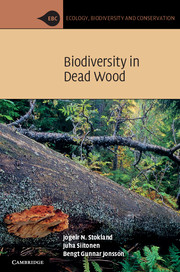Book contents
- Frontmatter
- Contents
- Preface
- 1 Introduction
- 2 Wood decomposition
- 3 The saproxylic food web
- 4 Other associations with dead woody material
- 5 Host-tree associations
- 6 Mortality factors and decay succession
- 7 Microhabitats
- 8 Tree size
- 9 The surrounding environment
- 10 Evolution of saproxylic organisms
- 11 Species diversity of saproxylic organisms
- 12 Natural forest dynamics
- 13 Dead wood and sustainable forest management
- 14 Population dynamics and evolutionary strategies
- 15 Threatened saproxylic species
- 16 Dead wood in agricultural and urban habitats
- 17 The value and future of saproxylic diversity
- References
- Index
8 - Tree size
Published online by Cambridge University Press: 05 June 2012
- Frontmatter
- Contents
- Preface
- 1 Introduction
- 2 Wood decomposition
- 3 The saproxylic food web
- 4 Other associations with dead woody material
- 5 Host-tree associations
- 6 Mortality factors and decay succession
- 7 Microhabitats
- 8 Tree size
- 9 The surrounding environment
- 10 Evolution of saproxylic organisms
- 11 Species diversity of saproxylic organisms
- 12 Natural forest dynamics
- 13 Dead wood and sustainable forest management
- 14 Population dynamics and evolutionary strategies
- 15 Threatened saproxylic species
- 16 Dead wood in agricultural and urban habitats
- 17 The value and future of saproxylic diversity
- References
- Index
Summary
Many saproxylic species are only able to use dead wood of a particular size or diameter. Some species prefer large trunks, while others favour small trees or thin branches. Some can use dead wood of many sizes while others are specialized within a narrow diameter range. In an individual dead tree, trunk sections with different diameters tend to be used by different species.
In this chapter, we describe the factors that contribute to the niche separation of species according to tree size. In general, the basal diameter of a tree is closely correlated with other dimensions such as height, surface area and volume, and each of these correlated factors can be important for individual species. For simplicity, the terms ‘diameter’ or ‘size’ are used in the text to refer to all the diameter-related effects, and the other factors (height, surface area, volume) are mentioned only when their effects are specifically considered. The preferences of individual species are reflected in species richness and species composition patterns that can be observed in dead-wood units belonging to different diameter classes. These patterns are reviewed in this chapter.
- Type
- Chapter
- Information
- Biodiversity in Dead Wood , pp. 183 - 193Publisher: Cambridge University PressPrint publication year: 2012
- 5
- Cited by



